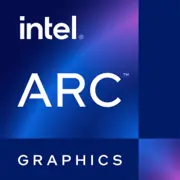Intel Arc B570

Intel Arc B570: A Detailed Review of the New Graphics Card for Gamers and Professionals
Exploring the capabilities, performance, and features of Intel's GPU
1. Architecture and Key Features
Xe-HPG: The Foundation for a New Generation
The Intel Arc B570 graphics card is built on the Xe-HPG architecture, specifically designed for gaming and professional tasks. Key elements include:
- Manufacturing Process: 6nm (TSMC N6), providing a balance between energy efficiency and performance.
- Compute Units: Up to 32 Xe cores (512 execution units), supporting hardware-accelerated ray tracing.
- XMX Matrix Cores: Analogous to NVIDIA's tensor cores, responsible for AI algorithm processing, including the XeSS (Intel’s Xe Super Sampling) technology.
Unique Features
- XeSS: Improves FPS through upscaling using artificial intelligence. In games like Cyberpunk 2077, the boost reaches 30-40% at 4K resolution.
- Hardware Ray Tracing: Supports ray tracing, but with lower efficiency compared to NVIDIA's RTX 40 series (approximately on par with RTX 3060 Ti).
- Deep Link: Optimizes collaboration with Intel integrated graphics for streaming and rendering.
2. Memory: Speed and Capacity
GDDR6: The Standard for Mid-Range
- Capacity: 12 GB — optimal for modern gaming and working with 3D models.
- Bus: 192-bit, providing a bandwidth of 384 GB/s (comparable to NVIDIA RTX 4060).
- Impact on Performance: In games with high textures (Horizon Forbidden West, Call of Duty: Modern Warfare III), 12 GB prevents FPS drops at ultra settings in 1440p.
3. In-Game Performance: Numbers and Resolutions
1080p: Maximum Comfort
- Apex Legends: 144 FPS (Ultra).
- Elden Ring: 68 FPS (maximum settings, no ray tracing).
- Cyberpunk 2077: 55 FPS (Ultra, XeSS Quality).
1440p: The Sweet Spot
- Red Dead Redemption 2: 62 FPS (High).
- Starfield: 48 FPS (Ultra, with XeSS Performance).
4K: For Enthusiasts with Caveats
- Forza Horizon 5: 45 FPS (Extreme, XeSS Balanced).
- Ray Tracing: Enabling it reduces FPS by 25-35%. For instance, Control: 32 FPS (1440p, RT Medium).
4. Professional Tasks: Not Just Gaming
Video Editing and Rendering
- DaVinci Resolve: Accelerated H.265 encoding via Quick Sync — rendering a 4K video is 20% faster than with the RTX 3060.
- Blender: Supports OpenCL and oneAPI, but rendering speed is 1.5 times slower than NVIDIA (due to the lack of CUDA).
Scientific Calculations
- TensorFlow/PyTorch: Compatibility with AI frameworks via plugins, but requires manual setup.
5. Power Consumption and Thermal Output
TDP and Recommendations
- TDP: 185 W — comparable to AMD RX 7600 XT.
- Cooling: Reference system with two 90mm fans. For stable operation under overclocking, a case with 3-4 fans is recommended.
- Power Supply: Minimum of 550 W (650 W recommended for overhead).
6. Comparison with Competitors
NVIDIA RTX 4060
- Pros of Arc B570: +4 GB of memory, better upscaling quality (XeSS vs DLSS 3).
- Cons: Weaker in ray tracing (by 15-20%), poorer driver optimization.
AMD RX 7600 XT
- Pros of Arc B570: Better support for professional tasks.
- Cons: RX 7600 XT is faster in Vulkan games (Doom Eternal).
7. Practical Tips
PC Building
- Motherboard: Must have UEFI with Resizable BAR (increases FPS by 10-15%).
- Drivers: Regularly update via Intel Driver & Support Assistant — stability improves with each month.
Game Optimization
- Enable XeSS in settings — it provides a greater boost than FSR 2.0.
- For ray tracing, choose Medium/High rather than Ultra.
8. Pros and Cons
Pros:
- Excellent price/performance ratio in DX12 and Vulkan.
- 12 GB of memory for future projects.
- Versatility for gaming and creative tasks.
Cons:
- Drivers are still "raw" for older games (e.g., GTA V).
- High power consumption at idle.
9. Final Conclusion: Who is the Arc B570 For?
This graphics card is a good choice for:
- Gamers who prefer modern games at 1440p with future-proofing.
- Content creators in need of an affordable GPU for editing and 3D work.
- Enthusiasts willing to experiment with drivers for cost savings.
Intel Arc B570 proves that there is room for a third player in the GPU market. It may not be perfect, but it offers impressive functionality for its price.
Basic
Memory Specifications
Theoretical Performance
Miscellaneous
Benchmarks
Compared to Other GPU
Share in social media
Or Link To Us
<a href="https://cputronic.com/gpu/intel-arc-b570" target="_blank">Intel Arc B570</a>